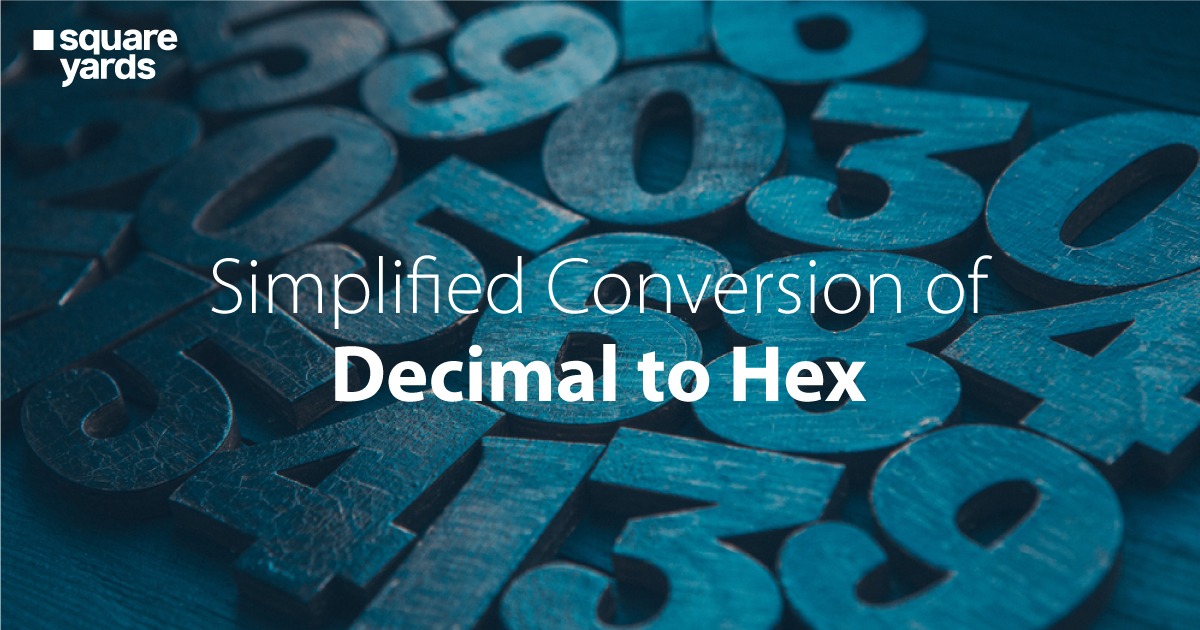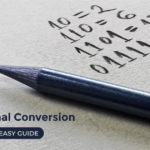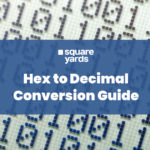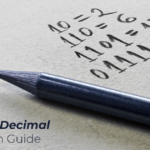Numbers are the building blocks of mathematics, but understanding different number systems can be tricky at times. Among the diverse number systems like binary, octal, decimal, and hexadecimal (generally called Hex), we’ll focus on decimal and hexadecimal today.
In this guide, we’ll explore the fundamentals of decimal and hex number systems and discover how to convert decimal to hex manually. With this guide, you will be able to understand the relationship between these two numerical formats. We will also include a conversion table and illustrative examples in this guide to make learning easier.
Table of contents
What is Decimal?
A decimal, often known as a decimal point, is a way to represent a fraction or a portion of a whole. It helps us to divide large numbers into smaller chunks. We use digits like 0 to 9 and a dot called the decimal point. The dot symbol represents decimals. It makes it simpler to handle the numbers. Decimals are useful in everyday life for measuring money, fractions, and percentages. They help us express values accurately and solve problems. It makes numbers more precise and helps us make sense of the world.
If you want to write five and a half numerically, you can use the decimal point and add the half after the decimal number, like 5.5.
Current Use of Decimal
Numbers that are between two whole numbers can be expressed using decimals. In many different mathematical processes, decimals are frequently utilised. When dealing with measurements, money, and scientific notation, they come in extremely handy.
For instance, the fraction 65/100, when simplified, is made up of the whole number 13 and a fraction, the number 0.65. In science and measurements, decimals help us measure things like length, weight, and temperature precisely. Decimals are used in data analysis and statistics. Additionally, decimals are widely used in technology, engineering, and computer programming to ensure accurate calculations and proper representation of data.
Decimals have a significant impact on the real estate industry. They are used for accurate pricing of properties, measuring their size and dimensions, calculating mortgage payments and interest rates, determining rental rates, evaluating property values, and representing commission and fees.
History of Decimal
The hexadecimal system dates back to ancient civilisation. One of the earliest recorded instances of such a system can be found in ancient Mesopotamia around 2000 BCE. The Babylonians used a sexagesimal system based on the number 60, which involved the use of place value notation. The decimal system, which is based on the number 10 and is familiar to us today, originated in ancient India. In the 7th century CE, the Indian mathematician Brahmagupta introduced the decimal system. He explained the use of zero and the positional notation system, where the value of a digit depends on its position in the number.
In the 9th century, the mathematician Al-Khwarizmi developed the decimal system and introduced it to the Western world. During the Renaissance, decimals became widely accepted in Europe. Mathematicians like Leonardo of Pisa (Fibonacci) and Simon Stevin played promoted the use of decimal fractions. This advancement made calculations and measurements more efficient and accurate.
In the 17th century, the mathematician John Napier introduced logarithms, which enabled complex calculations using decimal numbers. This invention had a profound impact on scientific and mathematical progress. The standardisation of the decimal system occurred with the establishment of the International System of Units (SI) in the 18th and 19th centuries. The metric system, based on powers of ten, replaced various local measurement systems and brought uniformity to measurements worldwide.
What is Hex?
Hexadecimal is a base-16 numbering system used in mathematics and computer science to represent and process binary-coded data effectively. There are 16 different digits used to represent the numbers. Its hexadecimal representation is h16.In the hexadecimal system, numbers are represented using sixteen symbols: the digits 0 to 9 and the letters A to F, where the letter A stands for 10, the letter B stands for 11, the letter C for 12, the letter D for 13, the letter E for 14, and the letter F for 15. Each hexadecimal digit corresponds to four binary digits (bits), which makes it particularly convenient for representing and converting binary data.
Current Use of Hex
Hexadecimal is frequently used in machine code and assembly programming languages. Therefore, Programmers commonly use hexadecimal numbering to simplify the binary numbering system. It is used frequently when discussing memory addresses. Additionally, it can represent numbers saved in a CPU’s register or main memory during the reforming stage of programming.
A linear relationship exists between 2 and 16, as 16 equals 24. As a result, the four binary digits are equal to one hexadecimal digit. Humans reduce and simplify the binary numbering systems used by computers with hexadecimal numbering systems. It is used to define memory locations, colours and fixing errors.
History of Hex
In 1963, IBM became the first company to introduce the current hexadecimal system in the field of computing. The Bendix G-15 computer utilised an older form in 1956, including the digits 0 through 9 and the letters u–z in lower case. Initially, not all numerals greater than nine were represented by the letters A through F. Some facilities preferred using the numerals 0 to 5 and the macron character (” “) to represent 10-15 values during the 1950s. Some mathematicians disagreed with the theory.
In a 1968 letter to the editor of the CACM, Bruce A. Martin of the Brookhaven National Laboratory offered an entirely new set of symbols based on bit positions since he found the decision to use the letters A–F somewhat irrational. His proposal did not meet with much success. Martin also found the option of using letters A to F illogical.
Relationship Between Decimal and Hex
Decimal and hex share a contrasting relationship with each other. Decimal, a base-10 numbering system, employs ten digits (0-9) to represent quantities. In contrast, hexadecimal is a base-16 system, utilising sixteen digits (0-9 and A-F) to represent numbers.
Each digit in both systems holds a specific place value, determined by its position in the number. In decimal, each digit’s place value is a power of 10 (1, 10, 100, 1000, etc.), while in hexadecimal, it is a power of 16 (1, 16, 256, 4096, etc.).
How to Convert Decimal to Hex?
Converting Decimal to Hex can be easily done by following the guidelines. We have listed the steps that can help you convert decimal to hex. Let us see them one by one:
Step 1: Write down the decimal number you wish to convert to hex.
Step 2: Now, divide this decimal number by 16.
Step 3: You have to keep the remainder aside.
Step 4: You have to divide the quotient by 16 once again. Repeat this process until getting the quotient value is zero.
Step 5: For the final step, you have to take the values of the remainder left in reverse order. This will give you the hexadecimal numbers.
After following these steps, you will get the hex number. Although, if you still face some difficulty, you can always use the online decimal-to-hex calculator. This online calculator is handy and acts as a quick decimal-to-hex converter tool. We have provided a couple of examples in the following section of this article to assist you in understanding the conversion process better.
Formula and Examples of Decimal-to-Hex Conversion
Examples of decimal-to-hex conversion are mentioned below.
Example 1:
Convert (860)10 into hexadecimal.
To convert decimal to hex, i.e. (860)10 to a hexadecimal number, follow the below-mentioned steps:
Step 1: First, divide 860 by 16.
860 ÷ 16 = 53 and remainder = 12
Step 2: Now, you have to divide the quotient 53 by 16.
53 ÷ 16 = 3 and remainder 5.
Step 3: Again divide the number 3 by 16, which will leave quotient=0 and remainder = 3.
Step 4: Now, you need to take the remainder in reverse order and substitute the corresponding hexadecimal value for it. You will get 35C as the answer.
Therefore, (860)10 = (35C)16
Example 2:
Convert (38)10 into hexadecimal.
To convert decimal to hex, i.e. (38)10 to a hexadecimal number, follow the below-mentioned steps:
Step 1: First, divide 38 by 16.
38 ÷ 16 = 2 and remainder = 6
Step 2: Again, divide quotient 2 by 16.
2 ÷ 16 = 0 and remainder 2.
Step 3: Now, take the remainder in reverse order and substitute the corresponding hexadecimal value for it. You will get 26 as the answer.
Therefore (38)10 = 26
Example 3:
Convert (1257) 10 into hexadecimal.
To convert decimal to hex, i.e. (1257) 10 to a hexadecimal number, follow the below-mentioned steps:
Step 1: First, divide 1257 by 16.
1257 ÷ 16 = 78 and remainder = 9
Step 2: Again, divide quotient 78 by 16.
78 ÷ 16 = 4 and the remainder 14.
Step 3: Again divide the number 4 by 16, which will leave quotient=0 and remainder = 4.
Step 4: Now take the remainder in reverse order and substitute the corresponding hexadecimal value for it. We get 4E9 as the answer.
Therefore (1257) 10 = 4E9
Example 4:
Convert (700)10 into hexadecimal.
To convert decimal to hex, i.e. (700)10 to a hexadecimal number, follow the below-mentioned steps:
Step 1: First, divide 700 by 16.
700 ÷ 16 = 43 and remainder = 12
Step 2: Again, divide quotient 43 by 16.
43 ÷ 16 = 2, and the remainder is 12.
Step 3: Again divide the number 2 by 16, which will leave quotient=0 and remainder = 2.
Step 4: Now take the remainder in reverse order and substitute the corresponding hexadecimal value for it. You will get 2BC as the answer.
Therefore, (700)10 = 2BC.
Example 5:
Convert (2000)10 into hexadecimal.
To convert decimal to hex, i.e. (2000)10 to a hexadecimal number, follow the below-mentioned steps:
Step 1: First, divide 2000 by 16.
2000 ÷ 16 = 125 and remainder = 0
Step 2: Again, divide the quotient 125 by 16.
125 ÷ 16 = 7, and the remainder is 13.
Step 3: Again divide the number 7 by 16, which will leave quotient=0 and remainder = 7.
Step 4: Now take the remainder in reverse order and substitute the corresponding hexadecimal value for it. You will get 7D0 as the answer.
Therefore, (2000)10 = 7D0.
Don’t miss It!
| Kilometer to Centimeter | Kilometer to Centimeter Conversion: Conversion Table, Examples |
| Centimeter to Meter | How to Convert Centimeter to Meter: Formula & Examples |
| Cubic Meter to Liter | How to Convert Cubic Meter to Liter: Formula & Examples |
| Cent to Square Feet | How to Convert Cent to Square Feet: Formula & Examples |
| Pounds to Kilogram | How to Convert Pounds to Kilogram: Formula & Examples |
| Milligrams to Grams | How to Convert Milligramsto Grams: Formula & Examples |
| Yard to Feet | How to Convert Yard to Feet Formula & Examples |
| Binary to Decimal | How to Convert Binary to Decimal: Formula & Examples |
Decimal-to-Hex Conversion Table
Based on the decimal-to-hex formula, we have included a decimal-to-hex conversion table below:
| Decimal Value | Hex Digit |
| 0 | 0 |
| 1 | 1 |
| 2 | 2 |
| 3 | 3 |
| 4 | 4 |
| 5 | 5 |
| 6 | 6 |
| 7 | 7 |
| 8 | 8 |
| 9 | 9 |
| 10 | A |
| 11 | B |
| 12 | C |
| 13 | D |
| 14 | E |
| 15 | F |
Difference Between Decimal and Hex
The difference between decimal and hex is tabulated below:
| Hex | Decimal |
| Hex system has 16 digits (0-9 and A-F). | Decimal uses 10 digits (0-9). |
| The place values are powers of 16 (16, 256, 4096, etc.). | In decimal, the place values are powers of 10 (10, 100, 1000, etc.). |
| Hexadecimal is commonly used in computer programming and digital electronics due to its compact representation of binary data. | Decimal is more prevalent in everyday life and standard arithmetic operations. |
| The largest single-digit number in hex is F (15 in decimal). | The largest single-digit number in decimal is 9. |
| Hexadecimal is useful for representing memory addresses and bitwise operations in programming. | Decimal is used in financial calculations, measurements, and everyday arithmetic. |
Conclusion
Being able to convert from decimal to hex is helpful, especially when programming computers and using digital devices. The step-by-step process guide helps you to easily convert decimal to hex. Understanding this straightforward yet effective conversion method will enable you to use various numbering systems and manage complicated data confidently. The conversion is a flexible tool that ensures correctness and streamlines mathematical operations.
FAQ’s about Decimal to Hex
Q1. How do you convert decimal to hex?
Firstly, divide your decimal number by 16. It is done because the base of a hexadecimal number system is 16. You then need to note down the value of the remainder. You need to keep dividing the remaining decimal number till you get 0. You need to note the remainder of each step. Remember to replace 10, 11, 12, 13, 14, and 15 with A, B, C, D, E, and F, respectively. After this, you need to write the remainder from bottom to top.
Q2. What is the base-16 in hexadecimal?
The base-16 system in hex means that it is a numbering system that uses 16 distinct symbols to represent numbers. These symbols are the regular decimal digits 0 to 9 and the letters A to F. In a base-16 system, each digit’s place value is a power of 16, meaning the value of each digit is determined by the position it occupies within the number.
Q3. Is hexadecimal base 16 or 8?
Hexadecimal is base-16 and not base-8.




















